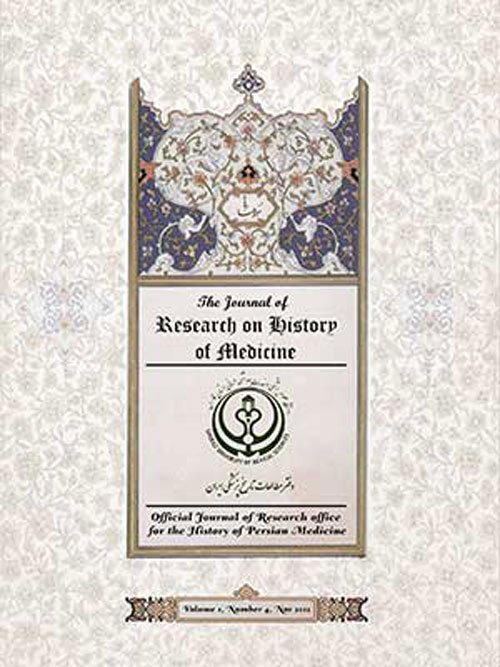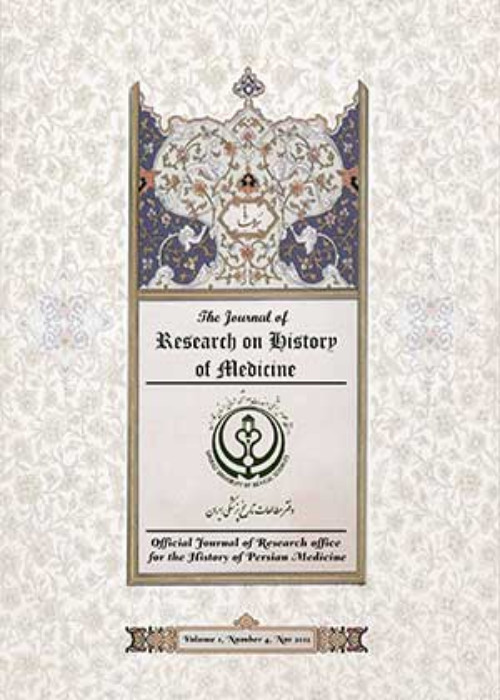فهرست مطالب

Journal of Research on History of Medicine
Volume:9 Issue: 3, Aug 2020
- تاریخ انتشار: 1399/06/26
- تعداد عناوین: 8
-
-
Pages 163-178Medical knowledge and its scientific and practical experience have long been important among countries with longstanding backgrounds. One of the most important branches of medical science is the science of anatomy, which has contributed to the treatment of unknown diseases and the surgery of the organs of the body. Among the medical anatomy versions, those who have used body anatomy imaging have been more successful in conveying concepts and medical education and treatment of diseases. Since the Renaissance, great painters such as De Vinci or Jan van Calkar have had a grand interest in anatomical imagery and have presented a particular style. In Iran, some medical manuscripts, such as Mansouri’s Anatomy Book or Akbari Medicine, have a specific anatomy of the body. The purpose of this article is to study the anatomy of the human body in some medical versions of the West and Iran illustrated. For this purpose, several specimens of medical prescription manuscripts are selected as examples. In Western versions, the design and presentation of components of the body are very influential in the style of Greek and Roman sculpture, and the figures are statuesque. But in Persian versions, the anatomical figures have a flexible body and no contractual dry state.Keywords: Anatomy, Medicine Illustration, Western Manuscripts, Persian Manuscripts, Medicine, Human body
-
Pages 179-188Urmia is located in the northwestern part of Iran with close proximity to Turkey and Iraq borders. Urmia has an important status in Iran’s medical history because it is the home of Iranian’s first modern medical school, established by Dr. Joseph Plumb Cochran in 1878. Joseph Plumb Cochran was born in an American missionary family in Urmia city. After graduating from New York University, School of Medicine, he returned to his birthplace in 1879 to establish the first teaching hospital in Iran which was called Westminster hospital. Even though he was very proficient in all the local languages of the region (Persian, Azari, Kurdish & Asori), he taught most of the courses in English and the first group of students graduated in 1883 under his direct supervision. The Medical School was well known for its top academic work in Iran. He worked for 27 years, visiting thousands of patients. Throughout these years, 28 physicians were graduated from this medical school. Dr. Joseph Plumb Cochran died at the age of 50 from Typhoid Fever and was buried in a small Christian cemetery in the village of Sir near the city of Urmia.Keywords: Medical history, Iranian medical school, Joseph Plumb Cochran, American missionary, Hospitals, Medicine, Urmia, Iran
-
Pages 189-204As one of the important departments of the hospital during the Islamic civilization in Iran and Islam, the Pharmacy with its various functions, namely manufacturing and providing medicine, has played an important role and gained special status in medical contexts. Different names given to pharmacy in texts belonging to the in Islamic period ranges from Khizāna al Adawiya (lit. spice store), Khizāna al-Sharāb (lit. wine1 store), pharmacy, Sydnh, to Sydnhnani. Since this research has taken a historical approach, by examining the historical status of hospital pharmacies in Iran and Islam, it seeks to examine the status and performance of hospital pharmacies in Iran and Islam in the period of Islamic civilization.A library research method was used for this historical study in which the data was collected from the library. Having found and collected historical sources and references, we categorized the contents to investigate and give an account of the status of the hospital pharmacy in Iran and Islam. Pharmacies in Iran and the Islamic world were one of the most important departments of the hospital, and pharmacists, along with physicians, played an important role in manufacturing drugs and medicine and giving them to patients. Pharmacists were ranked lower than physicians, and their performance was always monitored by Mohtasib to make sure that their function was in accordance to the law of sharia and o fake medicine was given to the patient. The history of pharmacies was closely related to the social, economic, cultural and therapeutic history of its time, comprising an integral part of Islamic culture and civilization.During the Islamic period, pharmacies in Iran and the Islamic world played an important role. In the Islamic period, there was a hierarchy in hospital pharmacies, including the head, the capacitor, pharmacist assistants and a number of vendors who worked under the supervision of the higher-rank staff or the senior pharmacist. They played an important role in improving patients’ health status.Keywords: Pharmacy, pharmacology, hospital, Islam, Iran
-
Pages 205-216Pediatrics is one of the most significant and practical disciplines in Medical Sciences. Indeed, the theoretical and clinical approaches of the physicians operating in this sphere have effectively impacted Medicine in Islamic civilization. The knowledge and perspectives of Muslim physicians have been varied depending on their dwelling regions, as each region has specific characteristics in terms of weather and climate. This would trigger the occurrence of some specific diseases or clinical symptoms peculiar to that region. Concerning children’s diseases, as displayed in the writings of Muslim scholars, they encompass either ailments common among adults and children, or those specific to children. These latter ailments include those which are region-specific, infectious/ contagious diseases and non-infectious / non-contagious diseases. Research into different types of children’s diseases is beyond the scope of the present study, and demands further research. However, this study introduces and describes some independent and general treatises concerned with Pediatrics. It is hoped that the findings of the study can pave the ground for further research into this discipline within the scope of the History of Medicine in Islamic civilization.Keywords: Pediatrics (Children’s Medicine), Children’s diseases, Medical writings, Midwifery writings
-
Pages 217-228In the lexicographic texts as well as in veterinary resources and specialized books on horses, the Islamic civilization period has focused on the types of sounds heard from horses; the concept of sounds has been explained as well. Exposure of horses to some infectious diseases affects their larynx in such a way that this consequently changes the animals’ sound. Laryngeal problems in horses have been identified in ancient veterinary medicine by examining or hearing how the horse whines. The methods of identifying laryngeal problems and changes in the sound of the infected horses have been mentioned in ancient veterinary and specialized horse books in detail (FARASNAMEH- BEITAREHNAMEH, etc.). The purpose of this study was to conceptually obtain and classify the sounds of an infected horse followed by identifying its laryngeal problems that altered its natural sound.This is a qualitative research article used to describe and document the analysis methods. Using the designed vocabulary keyword, references were searched in the veterinary, and some other medical literature resources, followed by employing various stages of content analysis method.FindingsHorses produce various sounds that include: Hamhameh, Sahil, Wahvaheh, Rahraheh, Shakhir, Nakhir, Karir, Dhabh, etc. For example, Sahil is divided in two: Salsaleh and Jaljaleh. For each of these voices, the meaning has been mentioned in the respective books. While infected, the animal’s voice is altered due to damage to the larynx, a vital member of the horse’s sound production. This impairs the horse’s communication with the rider or trainer.The findings showed that during the period of Islamic civilization, special attention was paid to horses. A variety of sounds produced by the animals were named, and their meanings were explained. Other unrelated Larynx problems also causing altered sounds due to laryngeal injuries were considered as independent illnesses, which they can be documented and read afterward.In conclusion, this study provides a comprehensive description of the identification and interpretation of sounds produced by horses in the history of the Islamic era. Also, further research in this field can determine the capability of veterinary knowledge in the Islamic regions more than before.Keywords: Horses, Veterinary medicine, Larynx, Civilization, Islamic era
-
Pages 229-238
In almost all fields of knowledge, whatever advancement is seen today is not entirely new. In fact, present advancement is based on ancillary knowledge. Even the idea of computer is also conceived from the ancillary knowledge. The same is the case with medical knowledge. Today a vast advancement in neuroscience and neurotechnology is seen. It is thought that present form of neurology resulted from day and night efforts of neuroscientists of present day. But the case is little different. The efforts of the present-day neuroscientists are appreciable but efforts made by the predecessor neuroscientists should not be ignored. As a matter of fact, a treasure of knowledge descended from early Greek, Persian, Roman, Arab and Indian scientists, especially in the field of medical science. In the present paper, an effort is made to present the ancillary knowledge of external senses as it was described by the Greek, Persian, Roman and Arab scholars. Simultaneously, comparative notes are also incorporated. This paper would help the reader to know about how much was known and how much is added to the knowledge of the external sense. By this, one can realize between the accuracy of logical imagination and of technological information.
Keywords: Nervous System, Unani Medicine (Greco-Persian Medicine), External Sense, Neurosciences, Information Technology -
Pages 239-244


